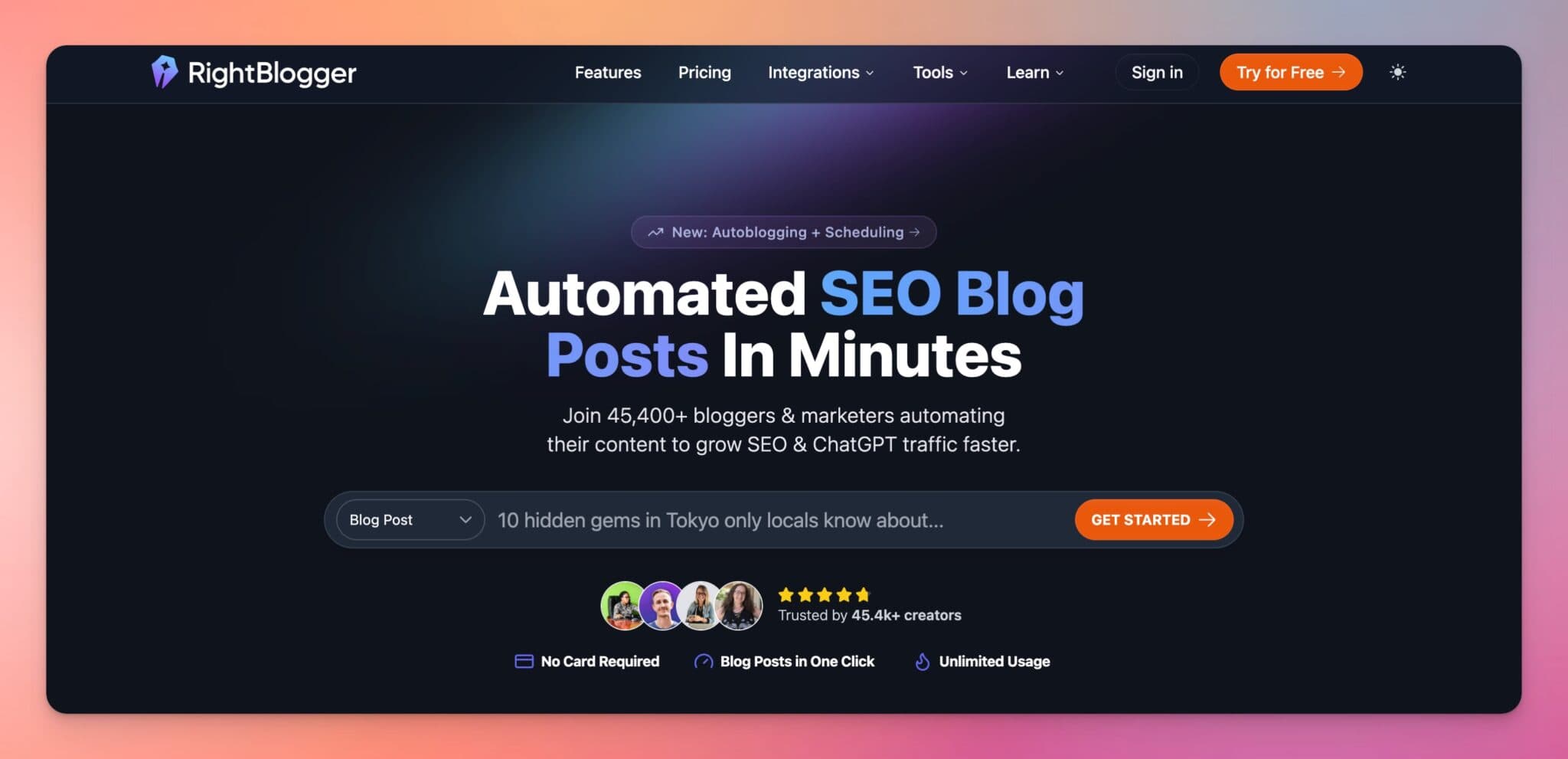AI Content Creation: A Complete Guide for 2025

For something so new (and controversial), it’s no surprise that AI content creation sometimes gets a bad rap. But how justified is that sentiment?
If you’re a marketer worrying about AI draining the originality from your content, a freelance writer struggling to find paying gigs, or a blogger who just isn’t sure how best to use these AI writing tools, you might have some worries about using AI.

🔑 The best way to approach AI (artificial intelligence) for content creation, is to see it for what it is: an automation tool that can make your life easier… not a magic wand that can (or ever will) do everything for you.
As a writer or blogger, you’ll always have the final say over your content. You don’t need to give away any control to AI. Instead, you can use AI in the ways that work for you and your business.
Let’s dig into how to use AI for content creation. You can pick and choose from the steps below: you don’t necessarily need to use AI for each of them (but I’d recommend at least giving AI a try, because you just might be surprised by the results).
📄 Long-form content: We’re focusing on long-form (blog) content in this article, but you can also use AI to create other types of content like social media posts, video scripts, artworks, and more. A great way to add these into the mix is to create your blog post first, then use AI to repurpose it for other mediums.
Create Automated SEO Blog Posts in Minutes with RightBlogger

Join 45,417+ bloggers, creators, marketers, writers, & business owners in using RightBlogger’s powerful autoblogging tools. You’ll unlock 80+ blogging, SEO, and marketing AI tools to create content faster & more effectively today. Plus, you’ll access our library of courses, a private community, Tool Studio’s AI lead magnet builder, and more.
AI Content Creation: A Step-by-step Guide
AI can help streamline and automate a lot of marketing and content-related tasks, but it needs human oversight at each step of your workflow if you want to get the best results.
We’ll go through 8 steps of the content creation process for blog posts, breaking down each stage and showing how you can use AI to help you.
Want to jump straight to a specific step? Here’s what we cover:
- Step 1. Conduct Keyword Research Around Your Topic
- Step 2. Build a Topic (Keyword) Cluster for an SEO Boost
- Step 3. Come Up with an Outline for Your Blog Post
- Step 4. Generate a First Draft of Your Article
- Step 5. Add or Design Visuals to Make Your Post Look Great
- Step 6. Edit and Proofread Your Content Carefully
- Step 7. Optimize Your Content for Search Engines
- Step 8. Promote Your Content to Bring in Traffic
1. Conduct Keyword Research Around Your Topic (for Content Ideas)
Keyword research is crucial for both search engine optimization (SEO) and creating content that your audience is looking for.
Instead of sifting manually through lots of data or using expensive SEO tools, you can let AI recommend keywords that will be great ones to rank for.
You can use AI tools to come up with lists of keywords, letting you instantly see vital stats like volume, difficulty (competition), and CPC.
Here’s an example from RightBlogger’s Keyword Research tool, which you can try out for free.
We chose the topic “camping” and the tool came up with this list of keywords, which we’ve sorted by volume:

From this list, you can quickly see that “camping in the rain” is a topic with high volume but only medium competition. Writing about KOA campgrounds could also be a great way to bring in traffic.
2. Build a Topic (Keyword) Cluster for an SEO Boost
Even if you’re already familiar with the concept of a topic cluster or keyword cluster, here’s a quick refresher:
A topic cluster model organizes website content around a central theme, anchored by a pillar page. This pillar page offers a comprehensive overview of the subject, setting the stage for a series of interlinked subtopic pages. Each subtopic page explores a detailed, specific aspect of the main theme, creating a robust network of related content.
Benefits of Using a Keyword Cluster:
- Boosts SEO authority: A keyword cluster helps search engines understand your site’s topical relevance, making it easier to rank for competitive terms.
- Creates more content ideas: One seed keyword can generate dozens of related topics, giving you a roadmap for future posts.
- Improves internal linking: Clusters naturally connect related posts, keeping readers engaged and reducing bounce rates.
- Covers topics in depth: By writing about both the main pillar topic and its subtopics, you position your site as a go-to authority.
- Supports long-term traffic growth: A cluster strategy builds compounding SEO value over time, instead of relying on one-off posts.
This is sometimes called a “hub and spoke” model of content, with the pillar page as the hub and the individual subtopic pages as the spokes.
This structure boosts your SEO efforts as it helps establish your site as an authoritative source on the topic, potentially enhancing your rankings for those keywords.
Brainstorming topic clusters can be tough if you’re doing it alone. It’s easy to miss things or to struggle to come up with coherent clusters.
This is a great place to bring in AI. You can create whole topic clusters in seconds from a single seed keyword (ideally, a keyword you chose in Step 1).
Here’s how it works, using the RightBlogger Keyword Cluster tool. We’ve used the “camping in the rain” high-volume keyword that we discovered during Step 1:

This is just the start of our keyword cluster list! RightBlogger came up with 12 different categories (like “Food and Cooking in the Rain” and “Gear Maintenance and Care”) as well as 5 or more bullet points for each.
Every single bullet point here could potentially become a whole post, giving you a massive number of related ideas in seconds.
3. Come Up with an Outline for Your Blog Post
Once you’ve chosen a single idea for your blog post, it’s time to come up with a detailed outline or brief for the whole thing.
This will make drafting the piece so much easier (whether you write it yourself, hire a freelancer, or use AI). A solid outline means you’ve nailed your blog post structure right from the start, so that readers can easily engage with your content. Plus, it keeps you on track as you write.
To make sure you incorporate as many of your own ideas and thoughts as possible, it’s often a good idea to create a draft outline before turning to AI. Then, go ahead and use tools like the RightBlogger Post Outline tool to come up with a full outline.
You can then either incorporate the AI’s ideas into your own outline, or if you loved the AI outline, edit it to add in some of your thoughts.
Here’s the start of the AI’s outline for a blog post provisionally titled “How to Stay Dry While Camping”.

4. Generate a First Draft of Your Article
This is where it all gets real … and where a lot of bloggers get stuck! Even if you’re an experienced marketer or freelance writer, coming up with a full first draft can be daunting.
If you’ve got a good outline, then you’re already a huge step ahead. AI-generated content can help get you the rest of the way there, without the time-consuming work of writing every word by hand.
Some bloggers and marketers are worried about using generative AI to write their content, but Google guidelines state that content that is high-quality, informative, and adheres to Google’s rules will not be penalized by their ranking algorithms, regardless of whether it’s been produced with the help of AI or not.
Essentially, you want your AI-assisted content to be as good as (if not better!) than the content you’d write without using AI.
That means you need to:
- Make sure your content is valuable and original. Bring in your own ideas, expertise, and personal experience. You want your blog post to be as useful and relevant to the reader as possible (matching what they’re looking for when they typed their query into Google).
- Check any facts, figures, and statistics that the AI comes up with. Sometimes, AI tools get things wrong. Just as you would fact-check a human writer’s work when editing, double-check any specific facts and figures from the AI.
- Use a high-quality AI content generator … and use it well. Tools like ChatGPT are only ever going to be as good as the prompts that you use. The more detailed and specific you are in your prompts, the better your blog post will be. Here at RightBlogger, we use hugely detailed prompting “behind the scenes” to produce great results with our various tools.
Lots of AI tools on the market let you create a blog post instantly from a keyword or title. They’re great timesavers … but by putting in just a little more work, you can get a blog post that truly matches your vision.
With RightBlogger, for instance, our AI Article Writer tool has a range of advanced options to help you finetune your post.
You can:
- Edit your outline: this is a great way to make sure everything that’s important to you gets included in your article. You can even select the option for a “Blank Outline” that you then fill out yourself, using your outline from the previous step.
- Change the tone and writing style: match the voice of the piece to your usual style, whether that’s excited, casual, professional, sales-oriented, or something else entirely. (RightBlogger has 16+ styles to choose from so you can easily match your brand voice.)
- Choose then length of your blog post: ideally, you want to match this to the typical length of high-ranking existing content for your keyword.
- Describe your target audience: this helps the AI tailor your content for the people reading it. For instance, you could say whether they’re beginners or experts, what age they are, and what motivates them.
- Include real-time knowledge: RightBlogger stays current, not just relying on stored data. Set it to actively crawl the web for the latest information to ensure your article includes the most up-to-date facts and figures.
- Include internal links: Link to other pages on your website for the best SEO practices and to build authority over time.
- Set the point of view: You control the narrative perspective of your article. Choose to write in the first person (“I”), second person (“you”), or third person (“they”) based on what best suits your content strategy and audience.
… and it doesn’t stop there! You can even include custom instructions for the AI writing assistant, asking the AI for highly specific points to be included in the content or making sure it structures your content in a particular way.

By spending a few minutes adding in details upfront, you’ll get a much better draft that’s fully tailored to your needs. This means a lot less time spent editing.
You can even create an SEO report in RightBlogger to analyze SERPs and figure out what are the key factors of other high ranking articles. This is great when paired with the auto-optimize feature that will optimize your article automatically with this report.
Tip: You can use the Chat feature above your completed article to talk with our AI chatbot, which uses natural language processing (NLP) to understand exactly what you’re asking. The chatbot can then adjust your content to make sure it’s a perfect match for you.
5. Add or Design Visuals to Make Your Post Look Great

Whether you’re creating blog posts, social media content, ads, or any other type of content, visuals matter.
One of the key benefits of AI in content creation is its ability to quickly produce high-quality graphics. This speeds up the production process and can also keep everything consistent and aligned with your brand.
You can choose to incorporate royalty-free images when generating your article (using the “Include Images?” toggle). But if you want to go further with creating custom images, then these tools are all great ones for image generation:
- Designs.ai: Offers a comprehensive design solution covering logo creation, video making, and more. It simplifies complex design tasks and provides access to a library of graphics, fonts, and design elements.
- Adobe Sensei: Automates tasks within Adobe’s Creative Cloud suite, including object selection, masking, pattern recognition, and image enhancement, speeding up the design process and boosting creativity.
- Google’s Nano Banana: One of the highest performing image generation models is now available in Google’s Gemini.
You can also use our AI image generator to quickly create images for your marketing needs.
If you’re using MidJourney, RightBlogger also has a MidJourney Prompt Generator tool, to help you get fantastic results:

6. Edit & Proofread Your Content Carefully
If you produced your content using AI, it should be free from typos and grammatical errors.
Tip: Writing in a language other than English? You can use RightBlogger for content in dozens of different languages, from to Afrikaans to Zulu! You can even switch to different varieties of English (the default is English US, but you can also pick UK, Canadian, or Australian English).
If you’ve added your own content or made changes, though, it’s definitely worth using AI to help you edit and proofread. AI can spot common mistakes like typos, common spelling errors, subject-verb agreement issues, and missed punctuation. It can scan vast amounts of text quickly and efficiently, flagging potential errors for your review.
Going even further, some AI tools can analyze your writing for stylistic and tone of voice issues, like overly wordy sentences, repetitive phrasing, or excessive use of the passive voice. It’s like having a top-notch editor at your side, helping you hone your writing so it’s truly outstanding.
You might already be familiar with some AI editing and proofreading tools like Grammarly. RightBlogger also has several tools to help you with this stage of the content creation process, including:
- Grammar Fixer: You can paste your entire article into our Grammar Fixer tool and let it parse the entire article for grammar check. It will then rewrite the article, fixing all grammatical errors while preserving the original text.
- Paraphrase Tool: If you feel some of your sentences might be awkward or you want to simplify and take out excessive details, use our Paraphrase tool to rewrite them.
- Rewriter Tool: This is especially useful if you want to rewrite existing content, while preserving all the same information. If you’re not sure which tool is best, take a look at our article about the difference between paraphrasing vs rewriting.
Here’s the Paraphrase Tool in action:

7. Optimize Your Content for Search Engines
Search engine optimization (SEO) is a hugely important way to use AI for content marketers and bloggers. After all, you want your content to rank as high as possible in Google and other search engines.
AI can help with all kinds of aspects of SEO and GEO, including:
- Keyword Placement: Integrating the right keywords strategically throughout the article enhances search engine visibility. You don’t want to go overboard, though: AI can help you find the right balance.
- Generating Catchy Titles and Meta Descriptions: AI can help you craft eye-catching titles and compelling meta descriptions to entice readers and to improve SEO performance. Take a look at RightBlogger’s Meta Title and Meta Description tools for help with these.
- Content Layout: As part of SEO optimization, AI can organize your content into distinct sections with defined headings and subheadings. This enhances readability and assists search engines in understanding the structure of your article, which can assist your content in ranking better.
- Word Count: Although some experts believe word count doesn’t matter in SEO, you should always aim for comprehensive, in-depth content that covers the topic in full. AI tools can recommend (and help you reach!) a word count that aligns with high-ranking content.
- Internal Linking: Some AI tools, like Surfer, can recommend internal links for your article. Doing this will guide readers toward related and relevant content on your site, helping to reduce bounce rates and bolster your SEO efforts.
This is where SEO reports in RightBlogger are a huge help. They’ll analyze top ranking pages in search to figure out what factors help them rank.
Here’s the RightBlogger Meta Title tool coming up with some great options for our How to Stay Dry While Camping post:

8. Promote Your Content to Bring in Traffic
The content creation process doesn’t stop the moment you hit the “Publish” button. If you want your content to truly serve its purpose, you need to think about your marketing strategy.
When it comes to content promotion, there are loads of different ways to use AI tools like RightBlogger.
You can use AI for many use cases like:
- Repurposing Content: Tools like our YouTube Video to Blog Post Generator are great if you prefer a video-first content creation process. Once you’ve made your video, you can quickly whip up a draft blog post in a matter of seconds—which then serves as the home base for the written version of your content online, forever. This is a key SEO best practice. (If you prefer to write first, before creating your video content, try the Blog Post to YouTube Video Script Generator instead!)
- Automated Content Scheduling: AI-powered tools like Buffer can manage the timing of content publication using machine learning, optimizing when content is released to maximize audience engagement.
- Content Localization: Some AI tools have the functionality to accurately translate content into various languages, broadening your reach to a worldwide audience. Our translator tool at RightBlogger is a great one to use here.
AI Content Creation FAQ
Can I use AI for content creation?
Yes, you can. AI tools like ChatGPT and RightBlogger can help with ideas, drafting, SEO, editing, images, and even translations. You stay in control and decide how much AI support you need.
What is the best AI content creator?
The best tool depends on your needs. RightBlogger is a strong choice for bloggers and marketers, with over 80 AI tools for writing, research, SEO, and promotion. Other popular options are Jasper, ChatGPT, and Grammarly.
How do I become an AI content creator?
Start by learning the basics of content writing and SEO. Test out different AI writing tools to get comfortable with them. Practice creating and editing content with AI support. Develop your own style, add personal touches, and keep learning as the technology changes.
Does Google punish AI-generated content?
No, Google does not punish AI-generated content simply for using AI. Google focuses on quality, usefulness, and originality, no matter how the content is created. Always review, fact-check, and edit your AI-assisted work before publishing.
Can AI replace original ideas or creativity in my content?
AI can help with research, drafts, and formatting, but it can’t replace your unique voice or personal stories. Use AI as a time-saver, but add your own insights and experiences to keep your content original and engaging.
How can I get my blog cited in AI tools like ChatGPT or Perplexity?
To improve AI visibility, ensure your site is indexed in Google (since most LLMs pull from it), structure your content with clear headings and lists, and publish original insights or statistics. Adding FAQ sections with schema helps AI pull direct answers, while keeping your site crawlable ensures your content gets discovered and cited.
AI Content Creation With RightBlogger (Our 80+ Best AI Tools for Creators)
Since AI content production is our forte, we want to demonstrate how we use AI in our processes at RightBlogger; so that you can apply similar strategies to your own projects.
RightBlogger is designed specifically for bloggers, content marketers, and all types of content creators, with a strong focus on enhancing the blogging experience.
We’ve got 80+ different tools (and we’re adding more all the time) … so let’s take a look at our key AI content creation tools for a whole range of different formats.
In the steps above we covered the following RightBlogger content creation and content writer tools:
- Keyword Research Tool
- Keyword Cluster Tool
- Post Outline Tool
- AI Article Writer Tool
- AI Image Generator Tool
- MidJourney Prompt Generator Tool
- Grammar Fixer Tool
- Paraphrase Tool
- Rewriter Tool
- Meta Title Tool
- Meta Description Tool
We also mentioned some key content promotion and repurposing tools:
You might also want to take a look at these other AI-powered content creation tools within RightBlogger. Our free account lets you try our tools at no charge (no credit card required).
- Smart Suggest Tool: get ideas specific to your blog (just pop in your blog’s URL)
- Post Introduction Tool: struggling to get your post started? Generate an intro in seconds.
- Post Conclusion Tool: Round your post off with a succint conclusion.
- FAQ Tool: Come up with a list of questions and answers to common questions about your topic (great way to add extra value to your articles).
- Listicle Writer Tool: Create a listicle blog post (great for shareable, viral-worthy content).
- Content Filler Tool: Need to quickly fill in some gaps to create engaging content? Let AI do the heavy lifting!
And the list doesn’t stop there. We have tons of AI content creation tools and templates for whipping up landing pages, product descriptions, ad copy, podcast scripts, social media marketing, and almost any piece of content or copywriting you can imagine. Unlike many other AI tools, our flat-rate pricing includes everything: no credits or word limits.
Ready to create high-quality content faster than ever before? Sign up for a free RightBlogger account and try our tools today.
Create Automated SEO Blog Posts in Minutes with RightBlogger

Join 45,417+ bloggers, creators, marketers, writers, & business owners in using RightBlogger’s powerful autoblogging tools. You’ll unlock 80+ blogging, SEO, and marketing AI tools to create content faster & more effectively today. Plus, you’ll access our library of courses, a private community, Tool Studio’s AI lead magnet builder, and more.
Is AI content creation safe for SEO in 2025, or will Google penalize my blog?
AI content creation is safe for SEO when your post is helpful, accurate, and made for readers first.
Google focuses on content quality, not whether a human or AI typed the first draft. If your article answers the search intent and adds real value, it can rank.
To stay safe, add your own experience, examples, and opinions so the post is not generic. Also fact-check numbers, quotes, and claims before you publish.
If you want a faster workflow, tools like RightBlogger SEO Reports can help you compare top results and see what your post should include to compete.
How do I keep AI-written content from sounding generic or “robotic”?
To avoid generic AI content, you need to guide the draft with your real voice and your real point of view.
Start with a clear outline that includes your unique angles, stories, and examples. Then have AI fill in sections instead of writing everything from scratch.
After the draft is done, rewrite the intro, add personal tips, and tighten the wording. This is where your content becomes “you” and not a copy of what is already online.
RightBlogger can help you keep a consistent style across posts with MyTone, so your articles sound like your brand every time.
What is the best step-by-step AI workflow to write a high-quality blog post?
A strong AI workflow is: keyword research, topic cluster, outline, draft, visuals, edit, SEO optimize, then promote.
Doing keyword research first helps you pick topics people actually search for. Building a cluster next helps you plan related posts and internal links, which can grow traffic over time.
An outline keeps the draft focused and saves time during editing. After you generate a draft, you still need to review it for clarity, accuracy, and missing details.
If you want help drafting faster, the RightBlogger AI Article Writer lets you control outline, tone, length, audience, and more.
How can RightBlogger help me create and optimize AI blog posts faster?
RightBlogger helps by combining research, writing, editing, and SEO tools in one place.
You can go from keyword idea to full draft quickly, then improve it with built-in tools for rewriting, grammar fixes, and meta titles and descriptions. This can cut hours off your normal process.
For SEO, you can use SERP-based reports to see what top ranking pages do well, then optimize your post to match. This makes it easier to publish content that competes.
A good next step is to pair RightBlogger SEO Reports with Auto Optimize for SEO improvements so your draft gets aligned with what search engines and readers expect.
How do I get my blog content cited in AI tools like ChatGPT and Perplexity?
To get cited by AI tools, your content needs to be easy to find, easy to understand, and clearly written.
Use clear headings, short sections, and helpful lists so your key points are easy to pull into an answer. Add an FAQ section that answers real questions in plain language.
Focus on original value, like your own process, real examples, or fresh data you collected. AI tools are more likely to reference pages that add something new.
Also make sure your site is crawlable and your content is indexed in Google, since many systems rely on search to discover sources.
Article by Andy Feliciotti
RightBlogger Co-Founder, Andy Feliciotti builds websites. He shares travel adventures and photography on YouTube and his travel blog.
New:Autoblogging + Scheduling
Automated SEO Blog Posts That Work
Try RightBlogger for free, we know you'll love it.
- No Card Required
- Blog Posts in One Click
- Unlimited Usage





Leave a comment
You must be logged in to comment.
Loading comments...